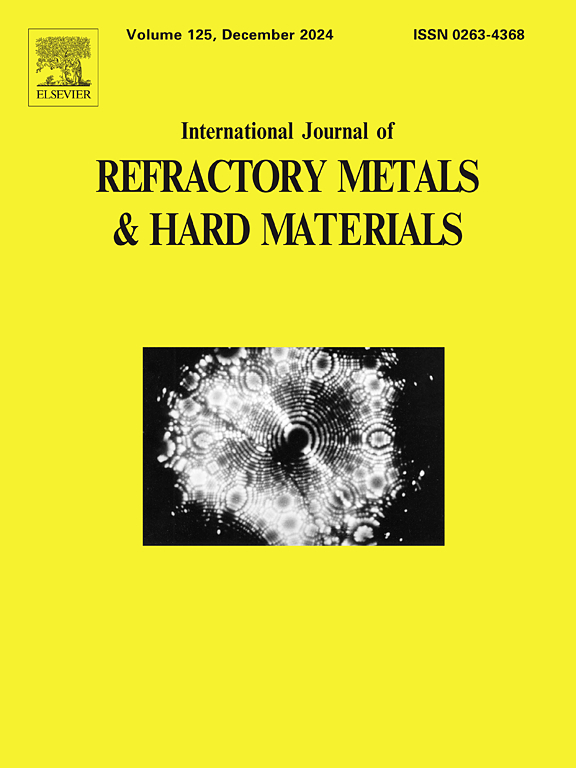Surface characterization of copper metal matrix composites reinforced with tungsten and molybdenum (Cu-W-Mo) through Microwave hybrid heating: A sustainable approach
IF 4.2
2区 材料科学
Q2 MATERIALS SCIENCE, MULTIDISCIPLINARY
International Journal of Refractory Metals & Hard Materials
Pub Date : 2025-03-16
DOI:10.1016/j.ijrmhm.2025.107147
引用次数: 0
Abstract
This study explores the innovative application of microwave hybrid heating (MHH) as a cost-effective and efficient method for fabricating advanced copper (Cu) powder-based metal matrix composites (MMCs). These composites are reinforced with tungsten (W) and molybdenum (Mo) powders at varying weight fractions (5 %, 10 %, and 15 %). The novelty of this research lies in the use of MHH, which combines microwave and conventional heating to achieve uniform, rapid processing, significantly reducing melting times and enhancing material properties. Using a microwave frequency of 2.45 GHz and a power setting of 900 W, pure Cu was successfully cast in just 7 min, while the reinforced composites melted even faster, within 4 min. Phase analysis was conducted using X-ray diffraction (XRD), which revealed the formation of Cu64O phases due to the process taking in the atmospheric environment. Microstructural studies further highlighted the presence of equiaxed grains and uniform dispersion of the W and Mo reinforcement particles throughout the Cu matrix. Increasing W and Mo content in Cu enhances the tensile strength and resistivity of the composite material. The MMC containing 15 % W and 15 % Mo achieved a Vickers microhardness value of 302.78 ± 15.13 HV which is 5.09 times higher than that of pure Cu. The composites exhibited excellent physical properties, including minimal porosity (less than 1.5 %). The Cu + 15 %W + 15 %Mo composite achieved an impressive relative density of 98.56 %, indicating excellent compaction and low defect levels. Moreover tensile strength of Cu + 15 %W + 15 %Mo was found 301 ± 15.05 MPa which was 1.65 times higher than that of pure Cu.

微波混合加热制备钨钼增强铜基复合材料的表面表征
本研究探索了微波混合加热(MHH)的创新应用,作为一种经济高效的方法来制造先进的铜(Cu)粉末基金属基复合材料(MMCs)。这些复合材料以不同重量分数(5%,10%和15%)的钨(W)和钼(Mo)粉末增强。这项研究的新颖之处在于使用MHH,将微波和传统加热相结合,实现均匀,快速的加工,显着减少熔化时间并提高材料性能。使用2.45 GHz的微波频率和900 W的功率设置,纯Cu在7分钟内成功铸造,而增强复合材料的熔化速度更快,在4分钟内完成。使用x射线衍射(XRD)进行相分析,发现Cu64O相的形成是由于在大气环境中进行的。显微组织研究进一步强调了等轴晶粒的存在以及W和Mo增强颗粒在Cu基体中的均匀分布。Cu中W和Mo含量的增加提高了复合材料的抗拉强度和电阻率。含有15% W和15% Mo的MMC的显微硬度值为302.78±15.13 HV,是纯Cu的5.09倍。复合材料表现出优异的物理性能,包括最小的孔隙率(小于1.5%)。Cu + 15% W + 15% Mo复合材料的相对密度达到了令人印象深刻的98.56%,表明良好的压实性和低缺陷水平。Cu + 15% W + 15% Mo合金的拉伸强度为301±15.05 MPa,是纯Cu合金的1.65倍。
本文章由计算机程序翻译,如有差异,请以英文原文为准。
求助全文
约1分钟内获得全文
求助全文
来源期刊
CiteScore
7.00
自引率
13.90%
发文量
236
审稿时长
35 days
期刊介绍:
The International Journal of Refractory Metals and Hard Materials (IJRMHM) publishes original research articles concerned with all aspects of refractory metals and hard materials. Refractory metals are defined as metals with melting points higher than 1800 °C. These are tungsten, molybdenum, chromium, tantalum, niobium, hafnium, and rhenium, as well as many compounds and alloys based thereupon. Hard materials that are included in the scope of this journal are defined as materials with hardness values higher than 1000 kg/mm2, primarily intended for applications as manufacturing tools or wear resistant components in mechanical systems. Thus they encompass carbides, nitrides and borides of metals, and related compounds. A special focus of this journal is put on the family of hardmetals, which is also known as cemented tungsten carbide, and cermets which are based on titanium carbide and carbonitrides with or without a metal binder. Ceramics and superhard materials including diamond and cubic boron nitride may also be accepted provided the subject material is presented as hard materials as defined above.

 求助内容:
求助内容: 应助结果提醒方式:
应助结果提醒方式:


